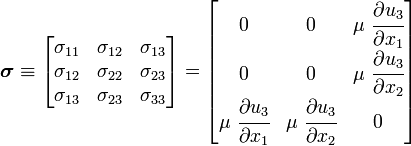Antiplane shear
Antiplane shear or antiplane strain[1] is a special state of strain in a body. This state of strain is achieved when the displacements in the body are zero in the plane of interest but nonzero in the direction perpendicular to the plane. For small strains, the strain tensor under antiplane shear can be written as
where the  plane is the plane of interest and the
plane is the plane of interest and the  direction is perpendicular to that plane.
direction is perpendicular to that plane.
Displacements
The displacement field that leads to a state of antiplane shear is (in rectangular Cartesian coordinates)
where  are the displacements in the
are the displacements in the  directions.
directions.
Stresses
For an isotropic, linear elastic material, the stress tensor that results from a state of antiplane shear can be expressed as
where  is the shear modulus of the material.
is the shear modulus of the material.
Equilibrium equation for antiplane shear
The conservation of linear momentum in the absence of inertial forces takes the form of the equilibrium equation. For general states of stress there are three equilibrium equations. However, for antiplane shear, with the assumption that body forces in the 1 and 2 directions are 0, these reduce to one equilibrium equation which is expressed as
where  is the body force in the
is the body force in the  direction and
direction and  . Note that this equation is valid only for infinitesimal strains.
. Note that this equation is valid only for infinitesimal strains.
Applications
The antiplane shear assumption is used to determine the stresses and displacements due to a screw dislocation.
References
- ↑ W. S. Slaughter, 2002, The Linearized Theory of Elasticity, Birkhauser



